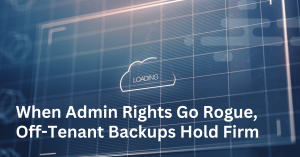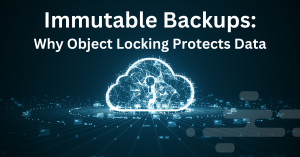Disaster recovery is supposed to be your safety net when things go wrong. But for many businesses, the pricing of traditional disaster recovery services can feel like a disaster in itself. Suddenly, the thing supposed to help avoid a crisis becomes the crisis; you’re facing unexpected bills that skyrocket out of control.
This cost rollercoaster is often a result of disaster recovery providers employing the “Hockey Stick Pricing Model”. These vendors may lure you in with attractive initial pricing using high deduplication estimates, which may not reflect your real data usage.. Once you’re invested, the prices take a sharp upward turn with consistent monthly increases, resembling the shape of a hockey stick.
Let’s look at how this works in practice and how you can protect yourself.
What is the Hockey Stick Pricing Model?
As mentioned above, the Hockey Stick Pricing Model is a strategy in which a product or service is initially offered at a low price. Low starting prices reduce barriers to entry, attracting more customers. Later, the price sharply increases month over month, aiming to capitalize on the established customer base.
In the context of cloud solutions and Disaster Recovery-as-a-Service (DRaaS), this happens when DRaaS providers bill based on predicted data storage (with deduplication factored in), which leaves room for vendors to adjust the numbers in their favor, unexpectedly increasing your costs.
Your bill will steadily increase month over month due to factors your cloud provider claims are “unpredictable” within your environment. This destabilizes your budget and can price you out of the service. This, especially when it comes to traditional disaster recovery, often entails hidden costs buried in complex contracts:
- Capacity-based Charges: You may pay a low base rate but face sudden price spikes when data storage or replication needs increase during a crisis.
- Unexpected Fees: When a disaster triggers failover to your recovery site, you might be hit with exorbitant charges for computing power, data transfer, and other fees such as declaration fees, live usage fees, and even testing fees.
- ‘Gotcha’ Clauses: Contracts may contain vague clauses that allow the provider to increase prices based on market conditions or unexpected resource demands.
When it comes to cloud solutions, especially cloud storage, one of the main culprits behind this hockey stick pricing is deduplication. DR providers often focus on the failover (getting you to the DR site) but lack clear failback strategies to help you transition back to normal operations once the crisis is resolved.
Deduplication - The Main Culprit
First, when we say deduplication often leads to hockey stick costs, it does not mean that deduplication is not a fantastic technology. On the contrary, it’s excellent for saving storage in the cloud. It finds redundant data blocks and stores them only once, reducing your storage footprint (and seeming cost).
The catch for disaster recovery though is that service providers will provide an initial attractive quote using a very high deduplication ratio. This ratio is an estimate of how much of your data they believe will be redundant. The higher the ratio, the smaller your predicted storage needs (and quoted price) will be.
But real-world data often isn’t as predictable. You may have unique files, frequent updates, or applications that don’t play nicely with deduplication. This means less redundancy over time. And less redundancy equals more actual storage needed and, of course, higher bills. In stark contrast, our approach to disaster recovery is fundamentally different:
It’s geared towards the ability to have a predictable bill, and one that is going to, within reason, remain static. The reason that we take this approach is that the only way your monthly bill can change is if you add a server for protection, or if you take one away. Or if you reprovision a virtual machine because it has natural growth. With this approach, your bill on a month-to-month basis would remain completely static. And this is a very rare offering in the industry.
How to Protect Yourself Against Hockey Stick Costs
Before committing to any disaster recovery solution, consider these points:
- Scrutinize the Fine Print: Don’t be blinded by low initial cost. Dig into how the pricing is calculated. Look for the deduplication ratio they are basing their quote on and any clauses about adjustments if deduplication rates change over time.
- Get it in Writing: Negotiate to have some guarantee of pricing consistency written into the contract. If they refuse, be wary.
- Conservative is King: Even with written guarantees, be conservative in your data growth projections. Overestimating your storage needs is better than a shocking bill.
- Transparency and Monitoring: Demand a transparent pricing model. Ensure you have tools to monitor your actual storage usage and deduplication ratio in real time.
- Consider Alternatives: Some service providers may offer a fixed pricing model for a certain amount of storage, regardless of deduplication. Or, keep a local backup, and only tier older, less frequently accessed data to the cloud. This can reduce cloud footprint and cost surges.
If you’re using traditional disaster recovery methods, you should also consider cloud-based DRaaS. It offers a more transparent and cost-effective approach:
- Pay-As-You-Go: Cloud solutions providers generally charge for what you actually use. This prevents nasty cost shocks when disaster strikes.
- Predictable Pricing: Costs are clearly outlined, and tiered service plans make budgeting easier.
- Flexibility: You can scale resources up and down to match your needs, avoiding overpaying for idle capacity.
Ultimately, if a service provider is not transparent about their pricing, gives you a quote that seems too good to be true, or is unwilling to negotiate reasonable safeguards, don’t be afraid to walk away and explore other options.
Final Words
Disaster recovery shouldn’t be a financial gamble. By understanding the pitfalls of hockey stick pricing, especially the deceptive nature of deduplication-based quotes, you can protect your business from unexpected financial blows during a crisis.
Don’t wait for disaster to strike to reevaluate your plan. Take these proactive steps to gain control of your disaster recovery costs:
- Audit Your Existing Agreements: If you have a traditional DR solution in place, scrutinize your contract with a focus on potential cost increases and hidden fees.
- Demand Transparency: Seek out providers that prioritize transparent pricing and predictable costs, and are willing to provide guarantees in writing.
- Explore Cloud-Based DRaaS: Investigate the potential benefits of pay-as-you-go models and flexible scaling offered by reputable DRaaS providers.
Remember, being prepared is not just about technology; it’s about financial resilience. Choose a disaster recovery solution that’s a true safety net – not another trap.






